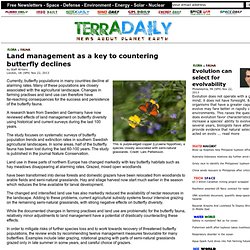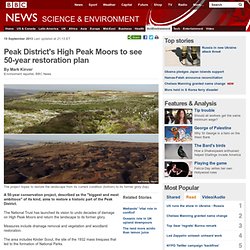

Land management as a key to countering butterfly declines. Currently, butterfly populations in many countries decline at alarming rates.

Many of these populations are closely associated with the agricultural landscape. Changes in farming practises and land use can therefore have far-reaching consequences for the success and persistence of the butterfly fauna. A research team from Sweden and Germany have now reviewed effects of land management on butterfly diversity using historical and current surveys during the last 100 years. The study focuses on systematic surveys of butterfly population trends and extinction rates in southern Swedish agricultural landscapes. In some areas, half of the butterfly fauna has been lost during the last 60-100 years. Land use in these parts of northern Europe has changed markedly with key butterfly habitats such as hay meadows disappearing at alarming rates. Have been transformed into dense forests and domestic grazers have been relocated from woodlands to arable fields and semi-natural grasslands. Admit it: we can't measure our ecological footprint - opinion - 25 November 2013.
Read full article Continue reading page |1|2 We need 1.5 Earths to sustain our lavish lifestyles?

Rubbish, says New Scientist's environment consultant: that's a publicity stunt which doesn't measure our overuse of resources HAVE you heard the one about the 1.5 Earths? Chances are you have: it is one of the most widely quoted ecological statistics of all, an easy-to-understand measure of our impact on the planet. The number has gained widespread currency, cited by governments, news media and in reports from United Nations agencies. The idea first came to prominence in a 1996 book called Our Ecological Footprint by William Rees, an ecologist at the University of British Columbia, and his student Mathis Wackernagel. Every year they declare Earth Overshoot Day, the date "when humanity exhausted nature's budget for the year" and began "drawing down local resource stocks and accumulating carbon dioxide in the atmosphere".
It's a nice publicity stunt. I fear the criticism is right. New methods of crop production and farmland birds: effects of plastic mulches on species richness and abundance - Skórka - 2013 - Journal of Applied Ecology. Peak District's High Peak Moors to see 50-year restoration plan. 19 September 2013Last updated at 21:13 ET By Mark Kinver Environment reporter, BBC News The project hopes to restore the landscape from its current condition (bottom) to its former glory (top) A 50-year conservation project, described as the "biggest and most ambitious" of its kind, aims to restore a historic part of the Peak District.

The National Trust has launched its vision to undo decades of damage on High Peak Moors and return the landscape to its former glory. Measures include drainage removal and vegetation and woodland restoration. The area includes Kinder Scout, the site of the 1932 mass trespass that led to the formation of National Parks. More than 10 million people are estimated to visit the area each year The Trust's rural enterprises director, Patrick Begg, said restoring the vital habitat could only be tackled over the long term. "There really is not much point committing to restore upland peat bogs over a five-year period as this just scratches the surface," he explained. Vision set for High Peak moors. The National Trust's “biggest and most ambitious” landscape-scale nature conservation initiative has been launched in the Peak District today (20 September).

It aims to inspire people and involve them in restoring a landscape of healthy peat bogs, diverse heaths and natural woodland rich in wildlife. With input from a wide range of people and organisations including the BMC, the Trust has mapped out a bold new 50-year vision for 10,000 hectares (40 square miles) of land it looks after in the High Peak moors. The area covers the boulder-strewn landscapes of rocky tors, dramatic valleys and cloughs and mile upon mile of wild and remote bog and heath. The iconic Kinder Scout and the spectacular Upper Derwent Valley are perhaps the best known parts and are essential elements of the much loved Peak District National Park. Conservation work will restore habitats such as bogs and heaths on the moor tops and heathland and woodlands in steep valleys, known as cloughs.